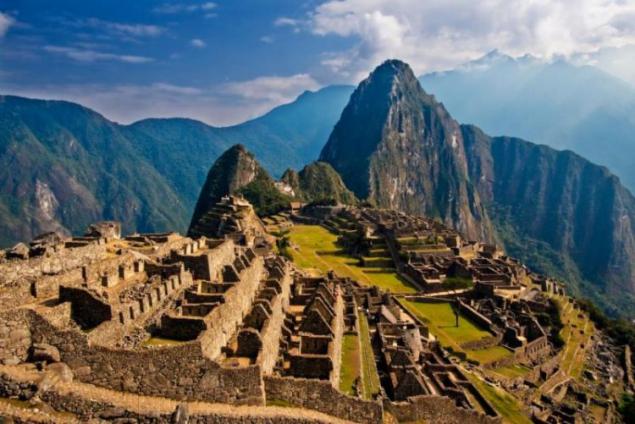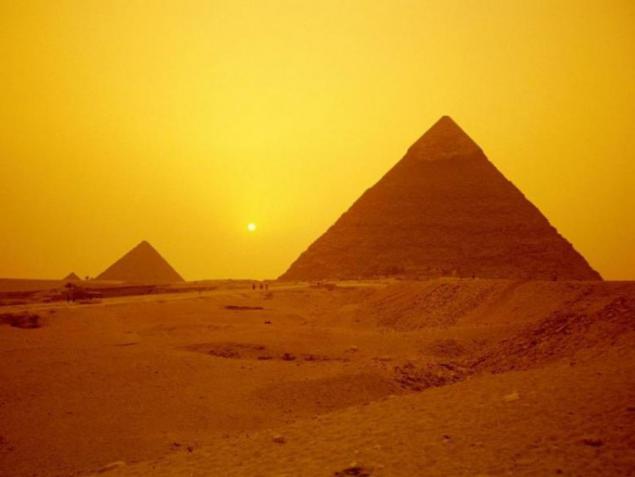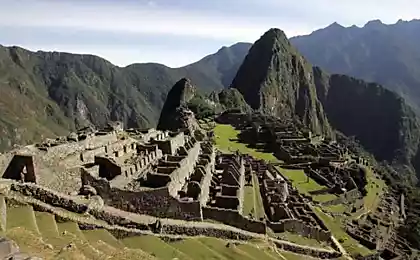1598
Impressive man-made landscapes
Sometimes the person is able to create something as massive and beautiful, as creations of nature. In this article we will talk about the most incredible man-made landscapes on the planet.
Gold mine "Super Pit", Australia

His appearance in the light industrial town Kargurli, located 595 km north-east of Perth, is obliged to the recent outbreak of the gold rush. In 1893, an Irish treasure hunter named Patrick Hanna found here a rich deposit of precious metal, giving rise to the world's largest gold mining career. This turn an ordinary Australian outback in one of the most impressive man-made landscapes in the world. The famous mine "Femiston Open Pit", which is no coincidence clung playful nickname "Super Pit", is still growing steadily in size. Now its length is about 3, 5 km, width - 1, 5 km, and the depth - more than 320 meters. Not knowing tired and not stopping for a moment, a huge dump trucks take out millions of tons of waste rock, leaving the joy of successful industrialists to 28 tons of gold a year. For those who are not employed in the extraction of precious deposits, but wants to see large-scale "golden hole" personally, Finders Keepers local company organizes two-hour tour, including the descent to the bottom of the quarry, cost 60 Australian dollars. And on the third Sunday of each month tour in the "Super Pit" are free of charge. In the open pit works and observation deck for tourists, open from 6 am to 9 pm.
Nazca, Peru

For many years Nazca, located in Peru, it was considered lifeless undeveloped desert. But in 1939, the US archaeologist Paul Kosok, flying over the Nazca, discovered a surprising phenomenon: huge lines crossing the plateau, to form geometric shapes, constellations and drawings of animals. Maria Reiche, to continue to study, confirmed that the furrow width up to 135 cm and a depth of 50 cm from the ground seemingly simple cleft, at a great distance transformed into giant geoglyphs. Since then, a mysterious creativity has acquired an incredible amount of myths and assumptions about how the ancient people who did not have on hand aircraft and surveying capabilities, able to create such large-scale rock carvings. In an effort to touch the puzzle, mankind has made something that was not possible elements: part geoglyphs ignominiously died under the wheels of off-road vehicles. Now, for the curious traveler built special viewing platforms. Hence, as with aircraft, perfectly visible unconventional themes of landscape art: 46-meter spider and 50-meter hummingbird looking midgets compared to the 285-meter pelican, 120-meter condor that spread its wings, and hundreds of geometric shapes, intersected by floral ornaments .
Machu Picchu, Peru

Many legends and secrets kept grassy stones of Machu Picchu - the great city of the Incas, lost among the mountains of Peru. Few things cleared up since 1911 when Hiram Bingham American traveler, fascinated by the search for the legendary Vilcabamba, accidentally discovered in the mountains towering complex. Even a century later, scientists from around the world, like a stunned researcher at Yale University, speculated: who, how and why he built a unique engineering masterpiece, and why its inhabitants mysteriously disappeared. While supporters of the traditional history adhere banal, but not very convincing versions that impossibly boulders transported from distant quarries on a high mountain by hand and polished to perfect faces with primitive tools undeveloped Indians, visionaries put forward a theory of theory. Creation of Machu Picchu is attributed and people from Atlantis, who gives people gleanings advanced civilization, and aliens from a distant planet Nubira, use the "city in the clouds" as a military base in the battles with the other alien race. One thing remains true: just $ 20 before the curious traveler overlook one of the most impressive man-made landscapes of the world, awarded UNESCO's attention.
Angkor Wat, Cambodia

An old legend, lifts the veil on the mysteries of the great Angkor Wat, tells us that long ago Preah Ket Mealea prince was a guest of the god Indra. Death, shaken by the beauty of the heavenly home, enjoy the peace, and the hospitable owner, pleasant enough company not stupid guest, was in no hurry to send him home. But, as usual, men's idyll violated women. Divine tevoda dancer who did not want to share the heavenly palace with a representative of the human race, was persuaded to part with Indra Preah Ket Mealea. Only one has asked Khmer prince returning home - and that people will have a palace like Indra possessions. So six kilometers from the modern Siem Reap, near the Tonle Sap Lake, there was a magnificent Angkor, has become one of the largest cities in the world X-XII centuries. But power and prosperity can not last forever. In 1431, Angkor, troops captured the neighboring Siam, was destroyed and fell into disrepair. Only January 22, 1861 majestic temple was again the world: three beautiful towers, like lotus buds, suddenly rose before the eyes of the Frenchman Henri Mouhot, get lost in the jungles of Cambodia. Since then, a huge shrine, which occupies an area of about 200 square kilometers, is considered one of the most celebrated cultural landscapes of Asia.
Pyramids of Giza, Egypt

Another place for those who believe in the sacred geometry and the golden section considers information about the structure of the universe, coded in architectural form, is located on the Giza Plateau. "Everything in the world is afraid of time, but time fears the pyramids" - says the Arab wisdom, confirming the well-known fact. Ziggurats were able to win the battle over the centuries, remains the last of the seven wonders of the world that has survived to the present day. Despite its popularity among tourists and archaeologists Egyptian attraction keeps its secrets. New research, crumbling foundations of traditional stories, regularly blow up the press with sensational headlines. "The Egyptian pyramids - a mirror Orion" - suggests Bauval and Gilbert. "Structures of Giza, as well as the temple of Angkor Wat, reflect a picture of the sky Neolithic" - echoes them Graham Hancock. "Devastated sarcophagus, hidden in the depths of the pyramid of Cheops was not the seat of the body of Pharaoh" - says Jacob Bryant. "Its walls had done a perfect hole, similar to the results of the diamond drill," - says Professor Smith. While scientists are trying to find confirmation of his bold theories, ancient architectural complex maze waiting for new guests. And from the top of the stone cones, as well as a century ago, opened excellent panorama of the kingdom of eternal sands.
Gold mine "Super Pit", Australia

His appearance in the light industrial town Kargurli, located 595 km north-east of Perth, is obliged to the recent outbreak of the gold rush. In 1893, an Irish treasure hunter named Patrick Hanna found here a rich deposit of precious metal, giving rise to the world's largest gold mining career. This turn an ordinary Australian outback in one of the most impressive man-made landscapes in the world. The famous mine "Femiston Open Pit", which is no coincidence clung playful nickname "Super Pit", is still growing steadily in size. Now its length is about 3, 5 km, width - 1, 5 km, and the depth - more than 320 meters. Not knowing tired and not stopping for a moment, a huge dump trucks take out millions of tons of waste rock, leaving the joy of successful industrialists to 28 tons of gold a year. For those who are not employed in the extraction of precious deposits, but wants to see large-scale "golden hole" personally, Finders Keepers local company organizes two-hour tour, including the descent to the bottom of the quarry, cost 60 Australian dollars. And on the third Sunday of each month tour in the "Super Pit" are free of charge. In the open pit works and observation deck for tourists, open from 6 am to 9 pm.
Nazca, Peru

For many years Nazca, located in Peru, it was considered lifeless undeveloped desert. But in 1939, the US archaeologist Paul Kosok, flying over the Nazca, discovered a surprising phenomenon: huge lines crossing the plateau, to form geometric shapes, constellations and drawings of animals. Maria Reiche, to continue to study, confirmed that the furrow width up to 135 cm and a depth of 50 cm from the ground seemingly simple cleft, at a great distance transformed into giant geoglyphs. Since then, a mysterious creativity has acquired an incredible amount of myths and assumptions about how the ancient people who did not have on hand aircraft and surveying capabilities, able to create such large-scale rock carvings. In an effort to touch the puzzle, mankind has made something that was not possible elements: part geoglyphs ignominiously died under the wheels of off-road vehicles. Now, for the curious traveler built special viewing platforms. Hence, as with aircraft, perfectly visible unconventional themes of landscape art: 46-meter spider and 50-meter hummingbird looking midgets compared to the 285-meter pelican, 120-meter condor that spread its wings, and hundreds of geometric shapes, intersected by floral ornaments .
Machu Picchu, Peru

Many legends and secrets kept grassy stones of Machu Picchu - the great city of the Incas, lost among the mountains of Peru. Few things cleared up since 1911 when Hiram Bingham American traveler, fascinated by the search for the legendary Vilcabamba, accidentally discovered in the mountains towering complex. Even a century later, scientists from around the world, like a stunned researcher at Yale University, speculated: who, how and why he built a unique engineering masterpiece, and why its inhabitants mysteriously disappeared. While supporters of the traditional history adhere banal, but not very convincing versions that impossibly boulders transported from distant quarries on a high mountain by hand and polished to perfect faces with primitive tools undeveloped Indians, visionaries put forward a theory of theory. Creation of Machu Picchu is attributed and people from Atlantis, who gives people gleanings advanced civilization, and aliens from a distant planet Nubira, use the "city in the clouds" as a military base in the battles with the other alien race. One thing remains true: just $ 20 before the curious traveler overlook one of the most impressive man-made landscapes of the world, awarded UNESCO's attention.
Angkor Wat, Cambodia

An old legend, lifts the veil on the mysteries of the great Angkor Wat, tells us that long ago Preah Ket Mealea prince was a guest of the god Indra. Death, shaken by the beauty of the heavenly home, enjoy the peace, and the hospitable owner, pleasant enough company not stupid guest, was in no hurry to send him home. But, as usual, men's idyll violated women. Divine tevoda dancer who did not want to share the heavenly palace with a representative of the human race, was persuaded to part with Indra Preah Ket Mealea. Only one has asked Khmer prince returning home - and that people will have a palace like Indra possessions. So six kilometers from the modern Siem Reap, near the Tonle Sap Lake, there was a magnificent Angkor, has become one of the largest cities in the world X-XII centuries. But power and prosperity can not last forever. In 1431, Angkor, troops captured the neighboring Siam, was destroyed and fell into disrepair. Only January 22, 1861 majestic temple was again the world: three beautiful towers, like lotus buds, suddenly rose before the eyes of the Frenchman Henri Mouhot, get lost in the jungles of Cambodia. Since then, a huge shrine, which occupies an area of about 200 square kilometers, is considered one of the most celebrated cultural landscapes of Asia.
Pyramids of Giza, Egypt

Another place for those who believe in the sacred geometry and the golden section considers information about the structure of the universe, coded in architectural form, is located on the Giza Plateau. "Everything in the world is afraid of time, but time fears the pyramids" - says the Arab wisdom, confirming the well-known fact. Ziggurats were able to win the battle over the centuries, remains the last of the seven wonders of the world that has survived to the present day. Despite its popularity among tourists and archaeologists Egyptian attraction keeps its secrets. New research, crumbling foundations of traditional stories, regularly blow up the press with sensational headlines. "The Egyptian pyramids - a mirror Orion" - suggests Bauval and Gilbert. "Structures of Giza, as well as the temple of Angkor Wat, reflect a picture of the sky Neolithic" - echoes them Graham Hancock. "Devastated sarcophagus, hidden in the depths of the pyramid of Cheops was not the seat of the body of Pharaoh" - says Jacob Bryant. "Its walls had done a perfect hole, similar to the results of the diamond drill," - says Professor Smith. While scientists are trying to find confirmation of his bold theories, ancient architectural complex maze waiting for new guests. And from the top of the stone cones, as well as a century ago, opened excellent panorama of the kingdom of eternal sands.























